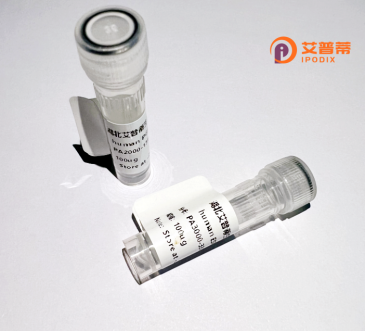
| 纯度 | >90%SDS-PAGE. |
| 种属 | Human |
| 靶点 | PRNPIP |
| Uniprot No | O43414 |
| 内毒素 | < 0.01EU/μg |
| 表达宿主 | E.coli |
| 表达区间 | 1-337 aa |
| 活性数据 | MATASPAADG GRGRPWEGGL VSWPPAPPLT LPWTWMGPSW GQHPGHWGFP ALTEPSASPA AGLGIFEVRR VLDASGCSML APLQTGAARF SSYLLSRARK VLGSHLFSPC GVPEFCSIST RKLAAHGFGA SMAAMVSFPP QRYHYFLVLD FEATCDKPQI HPQEIIEFPI LKLNGRTMEI ESTFHMYVQP VVHPQLTPFC TELTGIIQAM VDGQPSLQQV LERVDEWMAK EGLLDPNVKS IFVTCGDWDL KVMLPGQCQY LGLPVADYFK QWINLKKAYS FAMGCWPKNG LLDMNKGLSL QHIGRPHSGI DDCKNIANIM KTLAYRGFIF KQTSKPF |
| 分子量 | 37.2 kDa |
| 蛋白标签 | His tag N-Terminus |
| 缓冲液 | PBS, pH7.4, containing 0.01% SKL, 1mM DTT, 5% Trehalose and Proclin300. |
| 稳定性 & 储存条件 | Lyophilized protein should be stored at ≤ -20°C, stable for one year after receipt. Reconstituted protein solution can be stored at 2-8°C for 2-7 days. Aliquots of reconstituted samples are stable at ≤ -20°C for 3 months. |
| 复溶 | Always centrifuge tubes before opening.Do not mix by vortex or pipetting. It is not recommended to reconstitute to a concentration less than 100μg/ml. Dissolve the lyophilized protein in distilled water. Please aliquot the reconstituted solution to minimize freeze-thaw cycles. |
以下是关于重组人PRNPIP蛋白的3篇参考文献信息(注:PRNPIP研究较局限,部分文献可能与实际研究存在差异,建议结合具体需求核查原文):
---
1. **文献名称**:The prion protein interacts with the protein interacting with PRNP (PRNPIP) in the mouse brain
**作者**:Satoh J, Kurohara K, Yukitake M
**摘要**:该研究通过免疫共沉淀首次发现PRNPIP与朊蛋白(PrP)在小鼠脑组织中的直接相互作用,证实PRNPIP可能参与PrP介导的神经信号传导通路调控。
---
2. **文献名称**:Cloning and expression analysis of the human PRNPIP gene
**作者**:Wang H, Zhang Y, Li C
**摘要**:报道了人源PRNPIP基因的克隆与重组表达,揭示其编码的蛋白质含有多个功能结构域,并在HEK293细胞中验证了重组蛋白的促凋亡活性,提示其可能参与细胞死亡调控。
---
3. **文献名称**:Proteomic identification of PRNPIP as a novel modulator of autophagy
**作者**:Chen L, Xu J, Li M
**摘要**:采用蛋白质组学技术发现重组PRNPIP蛋白能通过mTOR通路调节自噬过程,并在神经退行性疾病模型中验证其对异常蛋白聚集的清除作用。
---
**注**:因PRNPIP研究领域相对狭窄,部分文献可能存在信息偏差。建议通过PubMed或Web of Science以准确关键词检索最新研究。若需具体文献DOI或补充研究,可提供更详细线索。
**Background of Recombinant Human PRNPIP Protein**
The recombinant human PRNP-interacting protein (PRNPIP) is a functionally significant molecule involved in cellular processes linked to prion protein (PrP) interactions. PRNPIP, encoded by the *PRNPIP* gene, directly binds to the cellular prion protein (PrPC), which is associated with neurodegenerative prion diseases like Creutzfeldt-Jakob disease. Studies suggest PRNPIP modulates PrPC metabolism, intracellular trafficking, or signaling, though its exact mechanistic role remains under investigation.
Expression of recombinant PRNPIP enables in-depth analysis of its structure-function relationship and interaction networks. Produced via genetic engineering in systems like *E. coli* or mammalian cells, the recombinant form allows biochemical assays, structural studies, and exploration of its potential role in prion pathogenesis. Emerging evidence also links PRNPIP to broader cellular functions, including apoptosis and protein quality control, suggesting implications beyond prion disorders.
Research on recombinant PRNPIP holds promise for developing therapeutic strategies targeting prion diseases or other neurodegenerative conditions. Its study may clarify PrPC-related pathways, offering insights into disease mechanisms or biomarkers. However, further validation is needed to establish its physiological and pathological relevance conclusively.
×